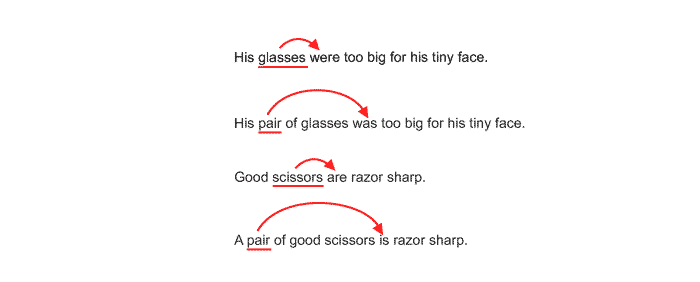Special Cases
Although the two previous sections dealt with the kinds of sentences in which most subject-verb agreement errors occur, there are several other occasional problems that you need to be aware of to edit your writing properly. This section is divided into examples of when to use singular verbs for agreement, when to use plural verbs for agreement, and when—depending on the meaning of the sentence—to use verbs of either number.
To have subject-verb agreement, use singular verbs
- with nouns that appear plural because they end in “s” but which are clearly referring to one thing.
- with titles.
- with sums of money or periods of time.



To have subject-verb agreement, use plural verbs with
- nouns such as pants, glasses, trousers, scissors, and pliers, unless they are preceded by the phrase
pair of . In that case, pair is the subject and, strangely enough, is a singular noun that calls for a singular verb.

In order to have subject-verb agreement—and depending on the meaning and structure of the sentence—use either singular or plural verbs with
- collective nouns. In most sentences, a collective noun refers to a group as a single unit, so it needs a singular verb. Ask yourself if the group is doing something together as a whole.
- Occasionally, however, a collective noun refers to the group as individual members, so it needs a plural verb. Ask yourself if the unit members are acting individually.
- words that indicate portions or fractional parts (for example,
two-thirds ,percent ,half of , part ,majority ,remainder ). The number of the verb depends on the meaning of the sentence. - inverted sentences. When a sentence is flip-flopped, and the verb comes before the subject rather than following it, finding the subject and verb and making sure they agree can be challenging. Inversion usually occurs in one of three situations.



- Questions have the subject after the verb.
- Hint: It’s easier to find the subject and verb if you make the question into a declarative statement, such as
"The response was positive or negative " or"The three doors are open ." - Sentences that start with
here orthere have the subject after the verb.Here andthere are not nouns or pronouns, so they will never be subjects; therefore, in a sentence beginning with one of those words, the actual subject is after the verb. - Sometimes writers invert sentences to get a reader’s attention or to emphasize a word, phrase, or idea. Again, it is easier to locate the subject and verb if you rearrange the sentence so the subject comes before the verb.



Before you test yourself on how well you understood this entire lesson, you might want to go to the subject-verb agreement exercises on this interactive site and do some extra practice.